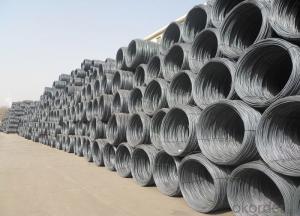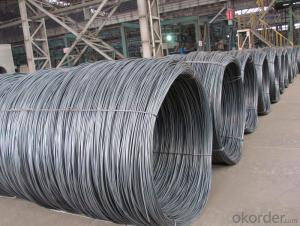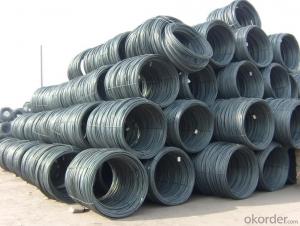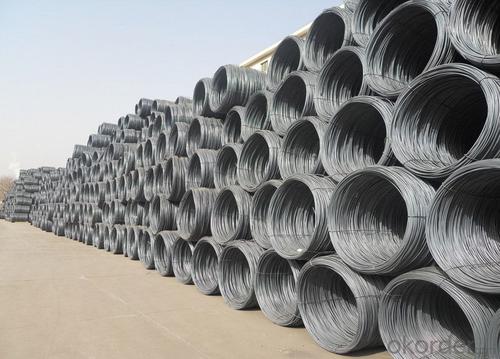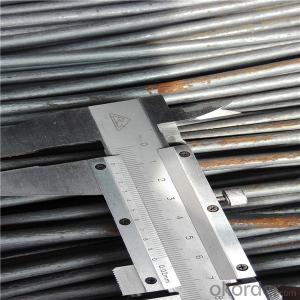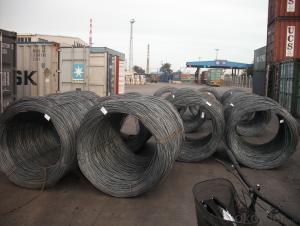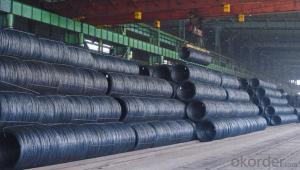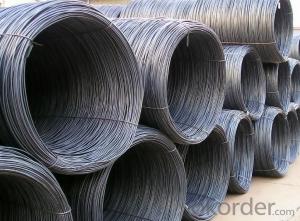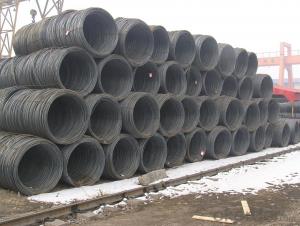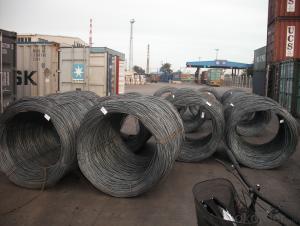Prime Hot Rolled Carbon Steel Wire Rod
- Loading Port:
- China Main Port
- Payment Terms:
- TT or LC
- Min Order Qty:
- 100 m.t.
- Supply Capability:
- 10000 m.t./month
OKorder Service Pledge
OKorder Financial Service
You Might Also Like
Product Description:
OKorder is offering Prime Hot Rolled Carbon Steel Wire Rod at great prices with worldwide shipping. Our supplier is a world-class manufacturer of steel, with our products utilized the world over. OKorder annually supplies products to African, South American and Asian markets. We provide quotations within 24 hours of receiving an inquiry and guarantee competitive prices.
Product Applications:
Prime Hot Rolled Carbon Steel Wire Rod are ideal for structural applications and are widely used in construction and manufacturing. Carbon steel wire rod is mainly used for reinforcement of reinforced concrete and welded structure or reprocessed (roberts , nail, etc.) materials, especially used to produce wire drawing, welding electrode, nails, spring, electronic, precise machinery parts and so on.
Product Advantages:
OKorder's Prime Hot Rolled Carbon Steel Wire Rod are durable, strong, and wide variety of sizes.
Main Product Features:
· Premium quality
· Prompt delivery & seaworthy packing (30 days after receiving deposit)
· Can be recycled and reused
· Mill test certification
· Professional Service
· Competitive pricing
Product Specifications:
Steel Grade: SAE1006-1018B
Standard: ASTM, GB
Diameter: 5.5mm, 6.5mm, 7mm,8mm,9mm,10mm,12mm,14mm
Type: in coil, coil weight around 2MT
Alloy or Not: Alloy
Technique: Hot Rolled
Place of Origin: China Mainland
Surface: round, no twisted, light and smooth
Trademark | Rank | Chemical composition (quality score) % | ||||||
C | Si | Mn | S | P | ||||
| ≤ |
| ≤ | ≤ | ||||
Q195 |
| 0.06-0.12 | 0.30 | 0.25 | 0.050 | 0.045 | ||
Q235 | A | 0.14-0.22 | 0.30 | 0.30-0.65 | 0.050 | 0.045 | ||
Q235 | B | 0.12-0.20 | 0.30 | 0.30-0.70 | 0.045 | 0.045 | ||
FAQ:
Q1: How many tons of steel products could be loaded in containers?
A1: Usually the steel products are delivered by bulk vessel because of the large quantity and the freight. However, there are no bulk vessel enter some seaports so that we have to deliver the cargo by containers. The 6m steel product can be loaded in 20FT container, but the quantity is changed according to the size, usually from 18tons to 25tons.
Q2: How do we guarantee the quality of our products?
A2: We have established an advanced quality management system which conducts strict quality tests at every step, from raw materials to the final product. At the same time, we provide extensive follow-up service assurances as required.
Q3: How soon can we receive the product after purchase?
A3: Within three days of placing an order, we will arrange production. The normal sizes with the normal grade can be produced within one month. The specific shipping date is dependent upon international and government factors, the delivery to international main port about 45-60days.
Images:
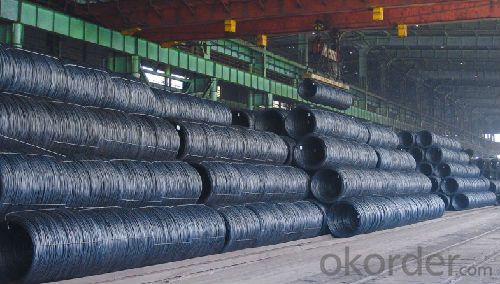
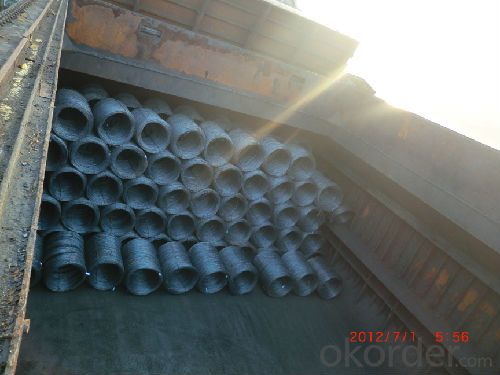
- Q: What are the main factors affecting the thermal conductivity of steel wire rod?
- The main factors affecting the thermal conductivity of steel wire rod are the composition of the steel, the presence of impurities, the crystal structure, and the temperature of the rod.
- Q: How is steel wire rod used in the manufacturing of wire shelving units?
- Steel wire rod is used in the manufacturing of wire shelving units as it is the primary material used to form the shelves and frames of the shelving units. The steel wire rod is often shaped, welded, and coated to create the desired shape and finish of the shelving unit. It provides strength, durability, and stability to the shelving unit, making it suitable for holding various items and providing storage solutions in homes, offices, and commercial spaces.
- Q: What are the common industry best practices for steel wire rod professionals?
- Some common industry best practices for steel wire rod professionals include ensuring the quality and consistency of the wire rod through regular testing and inspection, implementing efficient production processes to minimize waste and maximize productivity, adhering to strict safety protocols to protect workers and prevent accidents, staying updated with advancements in technology and equipment to improve efficiency and quality, and establishing strong communication and collaboration with suppliers, customers, and other stakeholders to meet their specific requirements and ensure smooth operations.
- Q: What are the different types of wire drawing dies used for steel wire rod?
- There are several types of wire drawing dies that are commonly used for steel wire rod. These include: 1. Single crystal natural diamond dies: These dies are made from a single crystal diamond and are known for their high hardness and wear resistance. They can be used for drawing high carbon steel wire rod as well as stainless steel wire rod. 2. Polycrystalline diamond (PCD) dies: PCD dies are made from multiple small diamond crystals that are bonded together. They offer good wear resistance and can be used for drawing steel wire rod with intermediate carbon content. 3. Tungsten carbide dies: Tungsten carbide is a hard and durable material that is often used for wire drawing dies. These dies can handle high carbon steel wire rod and are known for their ability to withstand high pressures and temperatures. 4. Natural diamond dies with carbide support: These dies have a natural diamond core with a carbide support structure. The diamond provides excellent wear resistance while the carbide support adds strength and stability. They are suitable for drawing steel wire rod with high carbon content. 5. PCD dies with carbide support: Similar to the above, these dies have a PCD core with a carbide support structure. They offer good wear resistance and can handle steel wire rod with intermediate carbon content. 6. Polycrystalline diamond composite (PDC) dies: PDC dies are made by sintering diamond particles with a binder material. They are known for their high wear resistance and are often used for drawing steel wire rod with low to medium carbon content. Each type of wire drawing die has its own advantages and is suitable for specific applications based on the carbon content and other properties of the steel wire rod being drawn.
- Q: How is the surface quality of steel wire rod evaluated?
- The surface quality of steel wire rod is evaluated by visually inspecting for any defects or imperfections on the surface, such as scratches, pits, cracks, or other surface irregularities. Additionally, the rod may undergo non-destructive testing methods like magnetic particle inspection or ultrasonic testing to identify any hidden flaws or internal defects.
- Q: How are steel wire rods used in the production of bicycle spokes?
- Bicycle spokes rely heavily on the inclusion of steel wire rods for their production. These rods, typically fashioned from high-quality steel, guarantee durability and strength. The manufacturing process initiates with the insertion of the wire rods into a machine that straightens and cuts them to the precise length required for spokes. Upon cutting, the wire rods undergo further processing to achieve the desired shape. This step involves passing the rods through a machine that molds them into a necessary "J-bend" shape, crucial for attaching the spokes to the bicycle hub and rim. Following the shaping process, the rods often experience a heat treatment procedure to enhance their strength and resilience. This process, known as annealing, includes heating the rods to a specific temperature and gradually cooling them. Annealing serves to eliminate any internal stresses and improve the overall mechanical properties of the spokes. Subsequently, the spokes are typically subjected to galvanization or a protective coating to prevent corrosion. This coating not only improves the spokes' visual appeal but also extends their lifespan by providing resistance against rust and other forms of deterioration. Lastly, the spokes are prepared for assembly into the bicycle wheel. They are inserted into the hub and threaded through the rim, forming a pattern that ensures optimal strength and stability. The spokes are then tightened to the appropriate tension, guaranteeing proper alignment and balance of the wheel. In conclusion, steel wire rods play a vital role in the production of bicycle spokes. They are responsible for shaping and strengthening the spokes, undergo heat treatment processes, and receive a protective coating to enhance their durability. Ultimately, the quality of the wire rods utilized significantly impacts the performance and longevity of bicycle spokes.
- Q: What are the major trade associations and organizations in the steel wire rod industry?
- Some major trade associations and organizations in the steel wire rod industry include the American Iron and Steel Institute (AISI), the Steel Manufacturers Association (SMA), and the International Wire and Machinery Association (IWMA). These organizations play a significant role in promoting the steel wire rod industry, advocating for its interests, and facilitating collaboration among industry stakeholders.
- Q: What are the standard surface roughness requirements for steel wire rod?
- The surface roughness requirements for steel wire rod vary based on the specific application and industry standards. In general, steel wire rod should have a smooth and uniform surface with minimal imperfections. When used in construction, such as for reinforcing concrete structures, the surface roughness requirements are relatively relaxed. It is common for steel wire rod in construction to have a surface roughness of Ra 3.2 to 6.3 micrometers (125 to 250 microinches). On the other hand, for more demanding applications like precision engineering or automotive manufacturing, higher surface quality is necessary. In these cases, the surface roughness requirements for steel wire rod are typically stricter, with a range of Ra 0.8 to 1.6 micrometers (32 to 63 microinches). It is important to note that these values are not universal and can vary depending on specific industry standards or customer preferences. Manufacturers and suppliers of steel wire rod usually provide detailed specifications and standards that must be met for specific applications, ensuring the desired surface roughness is achieved.
- Q: What are the different types of testing conducted on steel wire rod?
- There are several types of testing conducted on steel wire rod to ensure its quality and suitability for various applications. These tests include: 1. Chemical Analysis: This test determines the composition of the steel wire rod, including the percentage of various elements such as carbon, manganese, sulfur, phosphorus, and others. It helps to ensure that the wire rod meets the required specifications and standards. 2. Tensile Testing: This test measures the strength and elasticity of the steel wire rod. It involves applying a gradually increasing load to the rod until it breaks, and then analyzing the stress-strain relationship. Tensile testing helps to determine the ultimate tensile strength, yield strength, and elongation of the wire rod, which are crucial factors in assessing its quality. 3. Hardness Testing: This test measures the resistance of the steel wire rod to indentation or scratching. Different techniques like Brinell, Rockwell, or Vickers hardness tests are used to determine the hardness value. Hardness testing provides valuable information about the wire rod's ability to withstand wear, deformation, or penetration, which is essential in determining its suitability for specific applications. 4. Microstructure Analysis: Microscopic examination of the steel wire rod is conducted to assess its internal structure and grain size. This analysis helps to identify any defects, irregularities, or inclusions within the rod that could affect its strength, ductility, or other mechanical properties. 5. Ultrasonic Testing: This non-destructive testing technique uses high-frequency sound waves to detect any internal flaws or defects within the steel wire rod. It helps to identify issues such as cracks, voids, or inclusions that may compromise the rod's integrity or performance. 6. Dimensional Inspection: This test ensures that the steel wire rod meets the required dimensional specifications, such as diameter, length, straightness, and surface finish. Measurement tools like calipers, micrometers, or laser-based devices are used to verify these dimensions accurately. 7. Surface Quality Assessment: Various visual or non-destructive techniques are employed to inspect the surface of the steel wire rod for any surface defects, such as scratches, pits, scales, or corrosion. These assessments help to ensure that the rod has a smooth and defect-free surface, which is crucial for its performance and appearance in different applications. These different types of testing provide a comprehensive evaluation of the steel wire rod's chemical composition, mechanical properties, microstructure, dimensions, and surface quality. By conducting these tests, manufacturers and users can ensure that the wire rod meets the required standards and specifications, guaranteeing its quality and reliability in various industries, including construction, automotive, manufacturing, and others.
- Q: What are the disadvantages of using steel wire rod in manufacturing?
- One of the main disadvantages of using steel wire rod in manufacturing is its susceptibility to corrosion. Steel wire rod can rust if exposed to moisture or certain chemicals, which can weaken its structural integrity and shorten its lifespan. Additionally, steel wire rod may be heavy and difficult to handle, making it more challenging to work with during the manufacturing process. Finally, steel wire rod may have limited flexibility compared to other materials, which can limit its suitability for certain applications where flexibility is required.
Send your message to us
Prime Hot Rolled Carbon Steel Wire Rod
- Loading Port:
- China Main Port
- Payment Terms:
- TT or LC
- Min Order Qty:
- 100 m.t.
- Supply Capability:
- 10000 m.t./month
OKorder Service Pledge
OKorder Financial Service
Similar products
Hot products
Hot Searches
Related keywords
